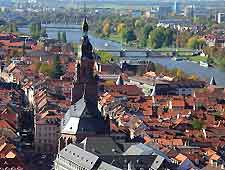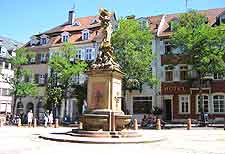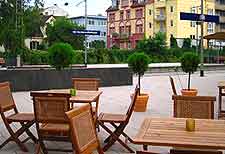Heidelberg Neighbourhoods, Locations and Districts
(Heidelberg, Baden-Württemberg, Germany)

The historical city of Heidelberg attracts visitors with its inspiring architecture, medieval feel and friendly residents. Now a prominent research and educational centre, the city of Heidelberg spans 14 districts, each with their own character.
Divided by the River Neckar, the city spans both sides of the river to form a picturesque and romantic setting that was in fact the one-time home of the German Romantic movement. Heidelberg's dozens of sites of literary, architectural and musical importance make this fascinating and enchanting German hub a great tourist destination. The main districts within Heidelberg are below.

Old Town (Altstadt)
Perhaps the most significant district for tourists is in the Old Town area of Heidelberg, where most visitors choose to reside amongst the winding, narrow alleyways. Set on the south bank of the River Neckar, the Old Town stretches inland, overshadowed by the Schloss (Castle). Best explored on foot, this condensed area contains most of the city's museums and a lively entertainment scene consisting of tavernas and pubs, as well as some more cosmopolitan restaurants. In addition, this primary district houses many of the city's historic meeting spots, including Market Place (Marktplatz), University Place (Universitätsplatz) and the Old Bridge (Alte Brücke).
Bergheim District
Facing Neuenheim across the river is the Bergheim district, centrally located just to the west of the Old Town. A charming combination of commercial and residential properties, visitors will find places to stay and restaurants to dine at more affordable prices than those in the nearby Old Town.
Handschuhsheim District
One of the city's northernmost districts, Handschuhsheim has a lengthy aristocratic history. Formerly the residence of the Handschuhsheim Dynasty, the imposing Tiefburg sits as a reminder to these days of glory. Teeming with visitor attractions, highlights include Handschuhsheimer Schlösschen and St. Vitus Church, the latter of which is home to the ornate graves of some of the Handschuhsheim. This part of Heidelberg is also a hotspot for gourmands and has the advantage of being off the beaten tourist track.

Kirchheim District
Visited mostly for its Tombs of Merowinger, dating from the Stone Age, this westerly district underwent damage in Heidelberg's 17th century conflicts.
After this turbulent century, the area mushroomed with development and became part of Heidelberg proper in 1920. Modern outlets make this a good district for shopping and dining.
Neuenheim District
Residing on the north bank of the river, Neuenheim was founded by the Romans as a fishing settlement. Boasting some stunning residential sites built in the Art Nouveau style, the district became favoured among intellectuals in the 19th century and is nowadays home to many educational institutes. Resident students and researchers keep this district lively and its sports grounds full. Of interest to visitors is the Botanical Garden and Heidelberg Zoo, both top attractions in their own right.
Südstadt / Weststadt Districts
Primarily a transport hub but boasting some beautiful houses characteristic of Heildelberg, Weststadt is located to the south-west of Bergheim. The sought-after residential parts of this district compete with those of the Südstadt, which now joins Weststadt to the south. Of interest is the Gaisbergturm, an architectural landmark that was built in 1876 by the Heidelberg Lock Association. Climb the spiral staircase to the top for spectacular views of the surrounding area.
Wieblingen District
Possibly the oldest settled area in the Neckar Valley, evidence of a mammoth and a Stone Age civilisation were found here. Wieblingen's extensive history makes it an interesting place to explore, however, like much of Heidelberg, damage caused in 17th century conflicts destroyed many of its historic buildings. Recent centuries have seen it develop as a major craft and industrial centre, with attractions such as the Bonsai Museum springing up.
Ziegelhausen District
Formerly known for its brick production, quarries and mining, this quiet city district sits on the north bank opposite Schlierbach and attracts those looking for a base from which to set off hiking in the countryside, the Neckar meadows and the lush forest known as Odenwald. Also of interest within the Ziegelhausen area of Heidelberg is the Stift Neuburg, a Benedictine cloister, and the Textile Museum Max Berk, as well as several pretty churches.
 The historical city of Heidelberg attracts visitors with its inspiring architecture, medieval feel and friendly residents. Now a prominent research and educational centre, the city of Heidelberg spans 14 districts, each with their own character.
The historical city of Heidelberg attracts visitors with its inspiring architecture, medieval feel and friendly residents. Now a prominent research and educational centre, the city of Heidelberg spans 14 districts, each with their own character.
